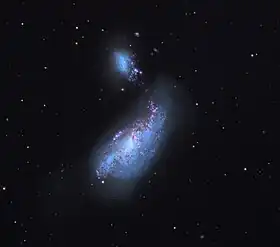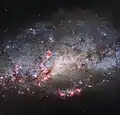| NGC 4490 | |
|---|---|
 NGC 4490 and satellite galaxy, NGC 4485 | |
| Observation data (J2000 epoch) | |
| Constellation | Canes Venatici |
| Right ascension | 12h 30m 36.2s[1] |
| Declination | 41° 38′ 38″[1] |
| Redshift | 565 ± 3 km/s[1] |
| Distance | 25.1 ± 5.0 Mly (7.7 ± 1.5 Mpc)[1] |
| Apparent magnitude (V) | 9.8 |
| Characteristics | |
| Type | SB(s)d pec [1] |
| Apparent size (V) | 6.3′ × 3.1′[1] |
| Other designations | |
| Arp 269, UGC 7651, PGC 41333[1] | |
NGC 4490, also known as the Cocoon Galaxy, is a barred spiral galaxy in the constellation Canes Venatici. William Herschel discovered it in 1788. It is known to be of the closest interacting/merging galactic system. The galaxy lies at a distance of 25 million light years from Earth making it located in the local universe. It interacts with its smaller companion NGC 4485 and as a result is a starburst galaxy. NGC 4490 and NGC 4485 are collectively known in the Atlas of Peculiar Galaxies as Arp 269. The two galaxies has already made their closest approach and are rushing away from each other. It's been discovered that NGC 4490 has a double nucleus.[2]
NGC 4490 is located 3/4° northwest of beta Canum Venaticorum and with apparent visual magnitude 9.8, can be observed with 15x100 binoculars.[3] It is a member of the Herschel 400 Catalogue. It belongs in Canes Venatici galaxy cloud II.
Stellar stream
A stellar stream 25,000 light years long connects the two interacting galaxies. The stellar stream is made of bright knots and large gas rich pockets. Young blue hot massive stars are formed in this region.[4]
Supernova
Two supernovae have been observed in NGC 4490: SN 1982F, a supernova of a unknown type and has a magnitude of16,[5] and SN 2008ax, a type II supernova with a magnitude of 13.[6][7]
Gallery
 Extreme tidal forces have carved out the shapes and properties of NGC 4490.[8]
Extreme tidal forces have carved out the shapes and properties of NGC 4490.[8]
See also
References
- 1 2 3 4 5 6 7 "NASA/IPAC Extragalactic Database". Results for NGC 4490. Retrieved 2016-01-18.
- ↑ Lawrence, A. L.; Kerton, C. R.; Struck, Curtis; Smith, Beverly J. (2020-02-27). "Revealing the Double Nucleus of NGC 4490". The Astrophysical Journal. 891 (1): 11. arXiv:2001.05601. Bibcode:2020ApJ...891...11L. doi:10.3847/1538-4357/ab6c6a. ISSN 1538-4357.
- ↑ Craig Crossen, Gerald Rhemann (2012). Sky Vistas: Astronomy for Binoculars and Richest-Field Telescopes. Springer Science+Business Media. p. 233. ISBN 978-3-7091-0626-6.
- ↑ information@eso.org. "Distant view of a galactic crash — NGC 4490 and NGC 4485 (ground-based image)". www.spacetelescope.org. Retrieved 2023-11-25.
- ↑ Transient Name Server entry for SN 1982F. Retrieved 29 March 2023.
- ↑ List of Supernovae IAU Central Bureau for Astronomical Telegrams. Retrieved 29 December 2015.
- ↑ David Bishop. "Supernova 2008ax in NGC 4490". supernovae.net (International Supernovae Network). Archived from the original on 8 April 2010. Retrieved 7 June 2010.
- ↑ "Bursting with Starbirth". www.spacetelescope.org. Retrieved 28 September 2017.
External links
- NGC 4490 on WikiSky: DSS2, SDSS, GALEX, IRAS, Hydrogen α, X-Ray, Astrophoto, Sky Map, Articles and images
- SEDS